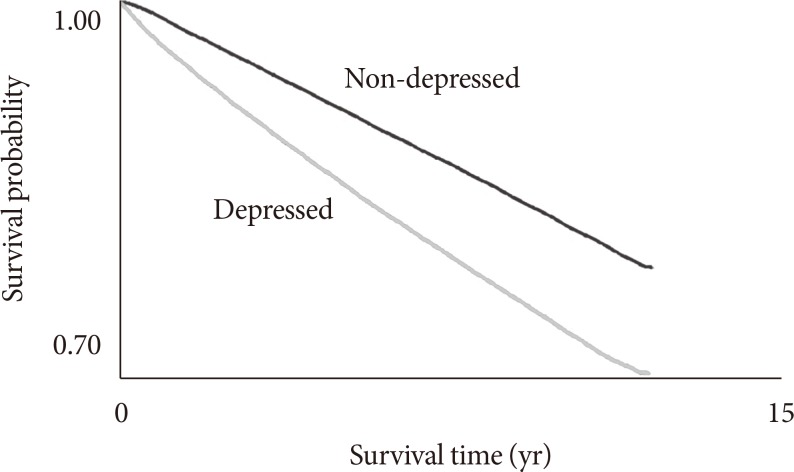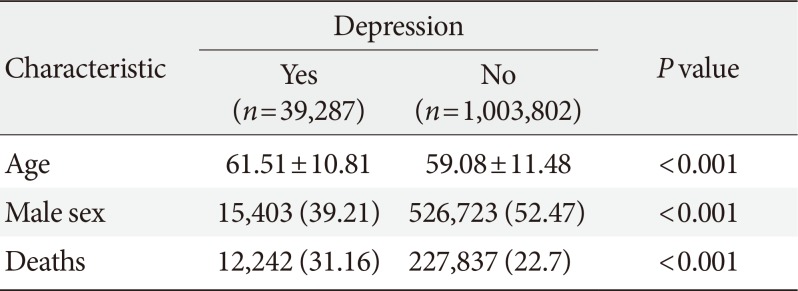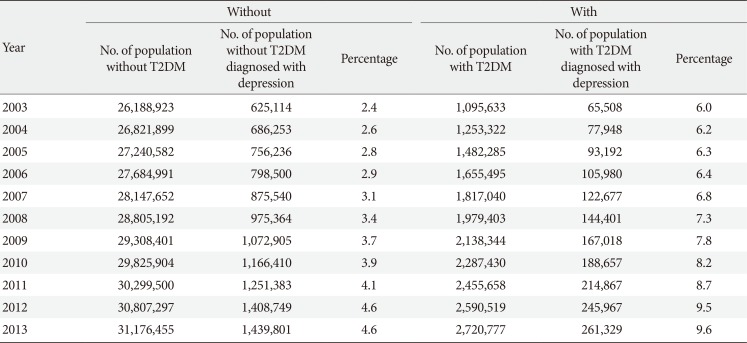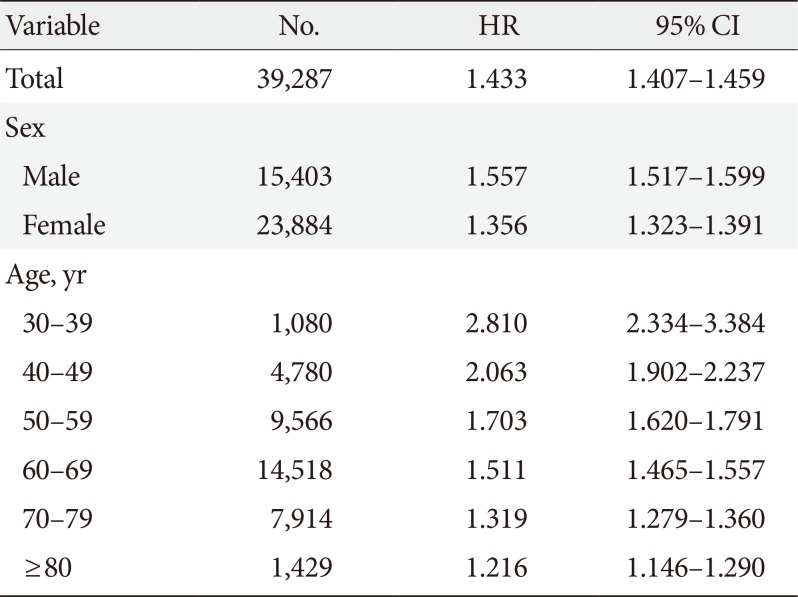1. Semenkovich K, Brown ME, Svrakic DM, Lustman PJ. Depression in type 2 diabetes mellitus: prevalence, impact, and treatment. Drugs. 2015; 75:577–587. PMID:
25851098.

2. Egede LE, Bishu KG, Walker RJ, Dismuke CE. Impact of diagnosed depression on healthcare costs in adults with and without diabetes: United States, 2004-2011. J Affect Disord. 2016; 195:119–126. PMID:
26890289.

3. Pederson JL, Warkentin LM, Majumdar SR, McAlister FA. Depressive symptoms are associated with higher rates of readmission or mortality after medical hospitalization: a systematic review and meta-analysis. J Hosp Med. 2016; 11:373–380. PMID:
26824220.

4. Aguilar A. Diabetes: depression is associated with renal complications. Nat Rev Nephrol. 2016; 12:444.
5. Iversen MM, Tell GS, Espehaug B, Midthjell K, Graue M, Rokne B, Berge LI, Ostbye T. Is depression a risk factor for diabetic foot ulcers? 11-years follow-up of the Nord-Trondelag Health Study (HUNT). J Diabetes Complications. 2015; 29:20–25. PMID:
25283486.
6. Barnacle M, Strand MA, Werremeyer A, Maack B, Petry N. Depression screening in diabetes care to improve outcomes: are we meeting the challenge? Diabetes Educ. 2016; 42:646–651. PMID:
27558266.
7. Brieler JA, Lustman PJ, Scherrer JF, Salas J, Schneider FD. Antidepressant medication use and glycaemic control in co-morbid type 2 diabetes and depression. Fam Pract. 2016; 33:30–36. PMID:
26743722.

8. Cezaretto A, Ferreira SR, Sharma S, Sadeghirad B, Kolahdooz F. Impact of lifestyle interventions on depressive symptoms in individuals at-risk of, or with, type 2 diabetes mellitus: a systematic review and meta-analysis of randomized controlled trials. Nutr Metab Cardiovasc Dis. 2016; 26:649–662. PMID:
27266986.

9. Iversen MM, Nefs G, Tell GS, Espehaug B, Midthjell K, Graue M, Pouwer F. Anxiety and depressive symptoms as predictors of all-cause mortality among people with insulin-naive type 2 diabetes: 17-year follow-up of the second Nord-Trondelag Health Survey (HUNT2), Norway. PLoS One. 2016; 11:e0160861. PMID:
27537359.
10. Nefs G, Pop VJ, Denollet J, Pouwer F. Depressive symptoms and all-cause mortality in people with type 2 diabetes: a focus on potential mechanisms. Br J Psychiatry. 2016; 209:142–149. PMID:
26846613.

11. White J, Zaninotto P, Walters K, Kivimaki M, Demakakos P, Biddulph J, Kumari M, De Oliveira C, Gallacher J, Batty GD. Duration of depressive symptoms and mortality risk: the English Longitudinal Study of Ageing (ELSA). Br J Psychiatry. 2016; 208:337–342. PMID:
26795425.

12. Park CY, Kim SY, Gil JW, Park MH, Park JH, Kim Y. Depression among Korean adults with type 2 diabetes mellitus: Ansan-Community-based Epidemiological Study. Osong Public Health Res Perspect. 2015; 6:224–232. PMID:
26473089.

13. Sung HN, Chae HS, Kim ES, Kim JS. Diabetes and depressive symptoms in Korean women: the fifth Korean National Health and Nutrition Examination Survey (2010-2011). Korean J Fam Med. 2014; 35:127–135. PMID:
24921031.

14. Kim NH, Lee J, Kim TJ, Kim NH, Choi KM, Baik SH, Choi DS, Pop-Busui R, Park Y, Kim SG. Body mass index and mortality in the general population and in subjects with chronic disease in Korea: a nationwide cohort study (2002-2010). PLoS One. 2015; 10:e0139924. PMID:
26462235.

15. Cho MJ, Seong SJ, Park JE, Chung IW, Lee YM, Bae A, Ahn JH, Lee DW, Bae JN, Cho SJ, Park JI, Son J, Chang SM, Hahm BJ, Lee JY, Sohn JH, Kim JS, Hong JP. Prevalence and correlates of DSM-IV mental disorders in South Korean adults: the Korean epidemiologic catchment area study 2011. Psychiatry Investig. 2015; 12:164–170.

16. Lustman PJ, Anderson RJ, Freedland KE, de Groot M, Carney RM, Clouse RE. Depression and poor glycemic control: a meta-analytic review of the literature. Diabetes Care. 2000; 23:934–942. PMID:
10895843.

17. de Groot M, Anderson R, Freedland KE, Clouse RE, Lustman PJ. Association of depression and diabetes complications: a meta-analysis. Psychosom Med. 2001; 63:619–630. PMID:
11485116.

18. D'Amato C, Morganti R, Greco C, Di Gennaro F, Cacciotti L, Longo S, Mataluni G, Lauro D, Marfia GA, Spallone V. Diabetic peripheral neuropathic pain is a stronger predictor of depression than other diabetic complications and comorbidities. Diab Vasc Dis Res. 2016; 13:418–428. PMID:
27334483.
19. Chung JH, Moon K, Kim DH, Min JW, Kim TH, Hwang HJ. Suicidal ideation and suicide attempts among diabetes mellitus: the Korea National Health and Nutrition Examination Survey (KNHANES IV, V) from 2007 to 2012. J Psychosom Res. 2014; 77:457–461. PMID:
25258359.

20. Kiecolt-Glaser JK, Glaser R. Depression and immune function: central pathways to morbidity and mortality. J Psychosom Res. 2002; 53:873–876. PMID:
12377296.
21. Hofmann M, Kohler B, Leichsenring F, Kruse J. Depression as a risk factor for mortality in individuals with diabetes: a meta-analysis of prospective studies. PLoS One. 2013; 8:e79809. PMID:
24278183.

22. Park M, Katon WJ, Wolf FM. Depression and risk of mortality in individuals with diabetes: a meta-analysis and systematic review. Gen Hosp Psychiatry. 2013; 35:217–225. PMID:
23415577.

23. Demmer RT, Gelb S, Suglia SF, Keyes KM, Aiello AE, Colombo PC, Galea S, Uddin M, Koenen KC, Kubzansky LD. Sex differences in the association between depression, anxiety, and type 2 diabetes mellitus. Psychosom Med. 2015; 77:467–477. PMID:
25867970.

24. Lipscombe C, Smith KJ, Gariepy G, Schmitz N. Gender differences in the association between lifestyle behaviors and diabetes distress in a community sample of adults with type 2 diabetes. J Diabetes. 2016; 8:269–278. PMID:
25850582.

25. Kim JH, Cho MJ, Hong JP, Bae JN, Cho SJ, Hahm BJ, Lee DW, Park JI, Lee JY, Jeon HJ, Chang SM. Gender differences in depressive symptom profile: results from nationwide general population surveys in Korea. J Korean Med Sci. 2015; 30:1659–1666. PMID:
26539012.

26. Rutte A, van Splunter MM, van der Heijden AA, Welschen LM, Elders PJ, Dekker JM, Snoek FJ, Enzlin P, Nijpels G. Prevalence and correlates of sexual dysfunction in men and women with type 2 diabetes. J Sex Marital Ther. 2015; 41:680–690. PMID:
25256659.

27. Furukawa S, Sakai T, Niiya T, Miyaoka H, Miyake T, Yamamoto S, Maruyama K, Ueda T, Senba H, Torisu M, Minami H, Onji M, Tanigawa T, Matsuura B, Hiasa Y, Miyake Y. Depressive symptoms and prevalence of erectile dysfunction in Japanese patients with type 2 diabetes mellitus: the Dogo Study. Int J Impot Res. 2017; 29:57–60. PMID:
27853168.

28. Corona G, Giorda CB, Cucinotta D, Guida P, Nada E. SUBITO-DE Study Group. Sexual dysfunction in type 2 diabetes at diagnosis: progression over time and drug and non-drug correlated factors. PLoS One. 2016; 11:e0157915. PMID:
27706160.

29. Cooper C, Rantell K, Blanchard M, McManus S, Dennis M, Brugha T, Jenkins R, Meltzer H, Bebbington P. Why are suicidal thoughts less prevalent in older age groups? Age differences in the correlates of suicidal thoughts in the English Adult Psychiatric Morbidity Survey 2007. J Affect Disord. 2015; 177:42–48. PMID:
25745834.

30. Joshi S, Dhungana RR, Subba UK. Illness perception and depressive symptoms among persons with type 2 diabetes mellitus: an analytical cross-sectional study in clinical settings in Nepal. J Diabetes Res. 2015; 2015:908374. PMID:
26236749.









 PDF
PDF ePub
ePub Citation
Citation Print
Print



 XML Download
XML Download